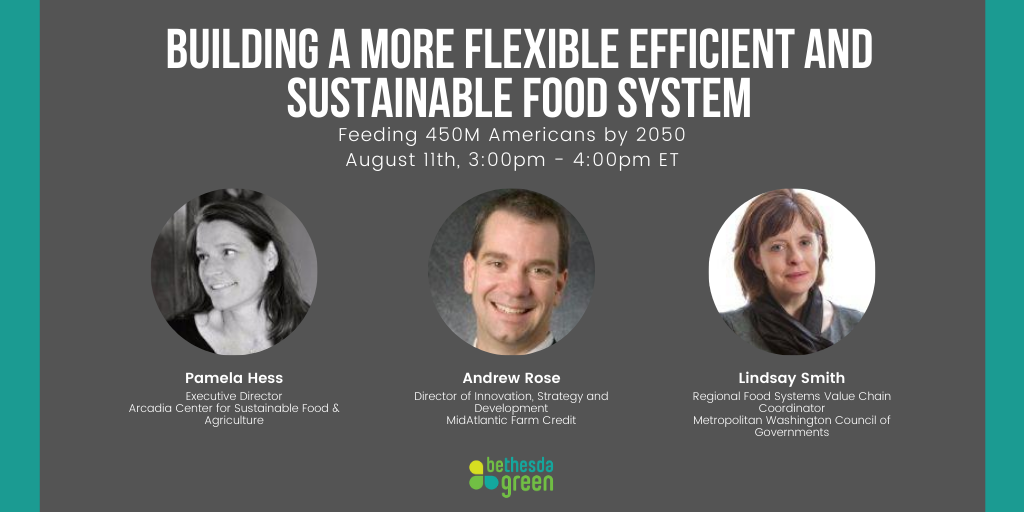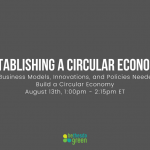Bethesda Green recently completed its Summer 2020 Speaker Series: Tackling Environmental Challenges Through Sustainable Entrepreneurship. This series aimed to educate and inspire prospective entrepreneurs by highlighting gaps in the market, and challenge them to address those gaps with innovative and sustainable for-profit business solutions. During this series, 18 speakers, including founders, industry experts, and policy makers, came together to discuss two primary topics: 1) Building a More Flexible, Efficient, and Sustainable Food System and 2) Establishing a Circular Economy.
The following is a summary of the fourth session.
Session #4: Feeding 450 Million Americans by 2050
Speakers included Pam Hess, Executive Director of the Arcadia Center for Sustainable Food & Agriculture, Andrew Rose, Director of Innovation, Strategy and Development at the MidAtlantic Farm Credit, and Lindsay Smith, Regional Food Systems Value Chain Coordinator for Metropolitan Washington Council of Governments.
Watch the full session on YouTube here: https://youtu.be/YTBimrU1Q3o

Food is a vital resource for human life, but government agencies do not always treat it as such. While the American food system has been failing for decades, the pandemic has further demonstrated the delicacy of our food supply chain and has exacerbated many of its existing challenges.
In particular, COVID-19 has shown that we cannot predict when, as Andrew Rose called them, “black swan events” will occur, so it’s absolutely crucial to have adaptability baked into the food system to help us better respond to these events. Panelists argued that one reason our current food system is susceptible is because Americans are becoming increasingly reliant on imports. Currently, 53.1% of fresh fruit and 31.1% of fresh vegetables are grown outside of the United States, and that number is expected to continue rising. This became a major concern when international travel all but ground to a halt as borders were closed and shutdowns gripped the globe earlier this year. Panelists agreed that in order to feed the future, the US government needs to build a resilient and redundant domestic food system. After all, Rose reminded attendees, one constant in the food system will always be that people have to eat.
Pam Hess, a former national security correspondent, believes that the food system is a matter of national security, and she’s not alone. In 2003, the Department of Homeland Security identified food and agriculture as part of the United States National Critical Infrastructure Plan, recognizing the system’s vulnerability. She argued that an adaptable, redundant domestic food system would allow for quick pivots in the case of a terrorist attack, natural disaster, or health crisis like a pandemic.
From a logistics side, the food supply system is vulnerable for a number of reasons, including its dependence on a small number of meat processing plants. In the DC-Maryland-Virginia (DMV) region, where workers tested positive for coronavirus at a chicken processing plant, forcing shutdowns, there was a buildup of chickens in the system with nowhere to be housed. As a result, nearly 2 million chickens were killed to “depopulate” the food supply chain, but the meat could not be processed for food because the processing plants were closed. Additionally, Hess gave the example that had local schools forged relationships with local farmers during the early days of the COVID crisis, they could have used their existing distribution channels to feed children who rely on schools for meals. Instead, schools’ relationships with national food distributors made them less nimble during the food system disruption and unable to meet the needs of their students.
But beyond logistics, Hess pointed to the fact that 71% of US youth aged 17-24 would not qualify for military service, primarily because of health problems stemming from unhealthy diets. Hess talked about the need for governments to address policies that often incentivize the production of low nutrient foods for the lowest possible price, which has dire consequences for our food system. Currently, an estimated 54.4 million Americans have both low income and low access to supermarket quality food. Hess says governments must understand that when citizens only have access to low cost, low nutrient foods, there will be huge costs down the road. A 2019 study found that unhealthy diets account for roughly 20% of all US health care costs, which is about $50 billion per year.
Yet feeding a rapidly growing population is not just a matter of growing more healthy food. In 2018, the World Resources Institute shared some of the solutions needed to sustainably feed 10 Billion people by 2050 sustainably. Panelists shared some of their own, reiterating the need to develop a resilient and redundant local and regional food system that aligns the interests of all stakeholders.
Lindsay Smith agrees about the importance of regional self-sufficiency, and recognizes the many challenges the region faces. She discussed how the Metropolitan Washington Council of Governments (MWCOG) borrowed the concept of self sufficiency from a USDA-funded research effort, Enhancing Food Security in the Northeast through Regional Food Systems (EFSNE), and applied it to their own regional study, What our Region Grows, the second edition of which was released in 2019. This report shows that food production is declining in the DMV region, impacting the region’s self-sufficiency and resiliency as the population continues to grow. MWCOG is working with elected officials to develop a standing committee on food and agriculture that will connect elected officials with industry experts to address the challenges reported.
Smith also discussed how expanding federal nutrition programs would mitigate the number of Americans that are food insecure, and advocated for protecting agricultural soil as land conversion and development degrades the fertility of soil, which is an increasingly crucial resource as food demand increases.
Andrew Rose reminded listeners that additional challenges facing the regional food system stem from an increased amount of saltwater intrusion as ocean levels rise, impacting not only the availability of arable land, but also requiring residents to relocate, further impacting regional production capacity.
Rose challenged listeners to think five years ahead, and to think about the problems facing society before providing solutions. With encroaching oceans, rising temperatures, and labor shortages in the agricultural sector, he encouraged entrepreneurs to examine the gaps in production, processing, and distribution, and to create some much needed solutions.
Some of the top problems needing solutions, the panelists argued, included a growing need for additional capacity for livestock butchering and processing, access to cooler space and flash freezing equipment to reduce food waste, more accessible and transparent information flows to strengthen the networks of the food system, promoting diversity and ensuring that entrepreneurs and farmers of color are put in the driver’s seat, and automation solutions in response to a shrinking labor force. These problems can be solved, but it will take a concerted effort from stakeholders from all corners of the economy to play their part.
Summaries and videos to the 2020 Bethesda Green Summer 2020 Speaker Series: Tackling Environmental Challenges Through Sustainable Entrepreneurship can be found here.
About the Authors:
Patty Simonton is the Director of the Be Green Business at Bethesda Green.
Sam Wenger is a Summer Intern at Bethesda Green’s Innovation Lab. He is pursuing a Master of Science in Energy and Sustainability from Northwestern University, and recently graduated from Cornell University with a Bachelor of Science in Operations Research & Information Engineering.





